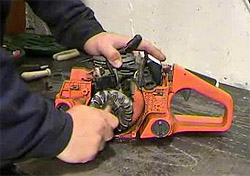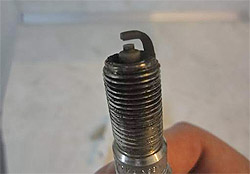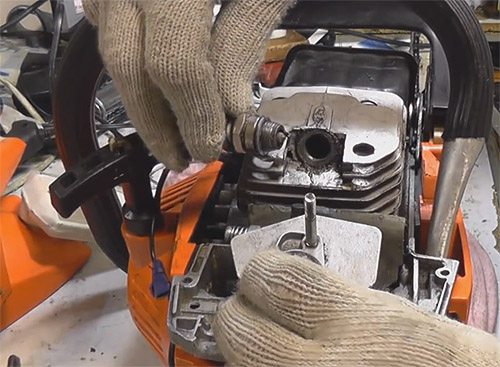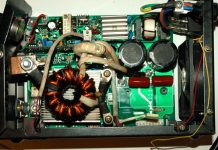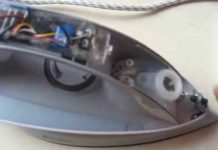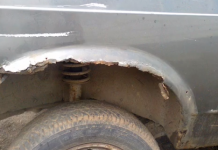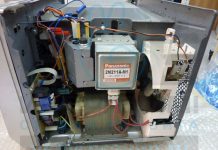It often happens that during prolonged operation, the walls of the exhaust pipe are covered with soot, which prevents the free exit of exhaust gases.
In this case, remove the muffler (if possible) and wash it with detergents, then dry it thoroughly with a hair dryer.
ATTENTION! Nagar contains carcinogens. During dry brushing, it can get into the lungs, which poses a threat to your health.
The cause of soot, as a rule, is the wrong ratio of gasoline to oil or the use of low-quality and incompatible oil.
Carefully read the operating instructions for the chainsaw to prevent this from happening in the future.
The wear of the cylinder and piston, the appearance of scratches and scuffs on their surface, the wear of piston rings or crankshaft bearings are all very serious damage. As a result, they lead to a pressure drop in the cylinder. In this case, it will be very difficult to start the engine.
Without disassembly, you can check the condition of the CPG as follows. Remove the muffler and look through the window that opens. Part of the surface of the cylinder will be visible.To obtain information about the state of the CPG, the compression in the engine is measured using a compression gauge, which must be installed in the spark plug hole. Turning the crankshaft (possible with a starter), measure the readings of the device. Compressometer readings should not be lower than 8-9 kgf / sq. cm (or 0.8-0.9 MPa).
If there is no compression gauge, you can check the presence of compression by eye by simply plugging the hole in the spark plug socket with your finger and pulling the starter, as shown in the photo below:
The cause of low compression may be coked piston rings or wear.
Each operating manual indicates the need to monitor the condition of the chain lubrication system.
Usually, system malfunctions occur due to clogging of the channels through which lubricant is supplied. With a slight leakage of oil, you can continue to operate. But if the oil leaks are large enough, then you need to check the tightness of the connection of the pipes to the pump fittings. You can fix the leak with a sealant or by replacing the tubes.
You should also pay attention to the condition of the oil pump. If there are cracks in its body, it must be replaced.
VIDEO
If the chain brake does not work, the cause may be contamination of the brake band with grease or sawdust with wood resin or the undercover space.
You can fix the problem by cleaning the dirt and replacing the brake band.
***
A chainsaw is a worthy replacement for hand saws and axes. Today, this tool is available in almost every household - it is indispensable for arranging a personal plot, construction and repair work. Intensive use and improper care of the tool can lead to premature failure. However, it is not at all necessary for the owner of a chainsaw to immediately contact the workshop - many of the malfunctions that can happen to it during operation can be eliminated on their own.
The main condition for a successful repair is the correct diagnosis. Therefore, in order to determine why the chainsaw failed and, most importantly, how to make it work again, you first need to know the features of its design.
It should be noted that it does not differ in particular complexity, since it includes:
engine (two-stroke gasoline);
functional part (saw bar and chain);
systems that ensure the joint operation of these two components (ignition, filtration, lubrication, etc.), that is, the tool as a whole.
In order to simplify the diagnosis of faults, they are usually divided into two main categories:
engine malfunctions;
malfunctions of other components of the chainsaw.
Most often, failures occur in engine systems, however, other parts of the tool, due to intensive use or improper care, can fail at any time. How to determine exactly where the breakdown occurred? Simple logic will help us with this.
If the problem is in the engine, it will:
do not start;
go deaf;
unsteady work;
overheat;
smoke;
develop insufficient power.
As for all other malfunctions, as a rule, they manifest themselves with a normally running motor.
If the chainsaw won't start, the first thing to do is to check the fuel mixture in the tank. By the way, it must be prepared in the proportions specified by the engine manufacturer, otherwise the tool simply will not start.
After making sure that the fuel mixture is correct and available, the ignition system should be checked. To do this, inspect the spark plug.
Her condition can say a lot:
indicates that the fuel mixture does not enter the carburetor, which means that the problem is not in the ignition;
is the result of an excess of the fuel mixture, which lies either in a violation of the engine start algorithm, or in improper carburetor adjustment;
this is a signal about the presence of low-quality oil in the engine lubrication system, incorrect carburetor settings, or an incorrectly prepared fuel mixture.
If the spark plug is splashed with fuel, wipe it thoroughly after removing it. The fuel supply system should also be cleaned. To do this, it overlaps, after which the starter is turned on. A carbon-covered candle must be carefully cleaned with an awl and emery.
When checking candles, attention should be paid to the distance between the electrodes (the normal gap is 0.5-0.65 mm), as well as the condition of the gasket and the presence of a spark. A damaged or worn gasket will have to be replaced, and the spark can be checked by putting on the ignition cable, connecting the cylinder and spark plug nut, and cranking the starter.
If the discharge does not occur, the candle must be replaced. In the event that a spark does not appear with a new candle, then the problem is in the connection with the high-voltage wire or in itself.
If the fuel mixture does not enter the cylinder, but the spark plug is working properly, this may mean that:
The fuel filter is clogged.
To clean this assembly, remove the fuel hose and check the jet. If it is weak, the filter must be removed through the filler hole of the fuel tank and cleaned or replaced in case of complete wear.
As a preventive measure, it is recommended to replace the fuel filter at least once every 3 months.
This is nothing more than a hole in the fuel tank cap, which is cleaned with an awl.
The fuel mixture is not supplied or supplied in insufficient quantity.
There may be several reasons for this:
the air filter is clogged (in this case, it must be removed, rinsed with water, dried and put back in place);
the carburetor settings have gone astray (which means this assembly must be re-adjusted);
the integrity of the carburetor membrane is broken (it must be replaced);
the carburetor channels are clogged (it must be disassembled and cleaned of all parts and assemblies).
If the chainsaw motor works fine at low speeds, but starts to stall and smoke at high speeds, the problem may be hiding in the muffler.
To check the quality of its work, do the following:
dismantling (with obligatory closing of the outlet);
disassembly (if the muffler is collapsible);
cleaning from carbon deposits using special detergents or by dry method;
drying (using a hair dryer);
reassembly and installation.
Dry cleaning without respiratory protection is not recommended. The carcinogens present in soot will be released into the surrounding atmosphere in the form of dust, the inhalation of which is extremely dangerous to health.
To prevent clogging of the muffler during the operation of the chainsaw, you should carefully monitor the composition of the fuel mixture and the quality of its components.
If the chainsaw engine does not start or cannot develop normal power, it is likely that there is not enough pressure in the engine cylinder to burn the fuel mixture. The reason for this may be the wear of the elements of the cylinder-piston group - piston, rings, bearings, etc. In order to assess the condition of this assembly, it is necessary to conduct a visual inspection of it, after removing the muffler.
For a more complete diagnosis, a compression gauge is placed in the spark plug hole of a two-stroke chainsaw engine. It measures the compression in the engine.Based on the results of the check, one can judge the state of the CPG, however, accurate facts can only be obtained with a complete disassembly of the assembly.
If there are chips or scratches on the piston, it is obvious that it will have to be replaced. The same applies to deformed or broken piston rings - for normal engine operation, they must be fully functional and clean from carbon deposits.
A properly working carburetor guarantees maximum efficiency of the chainsaw, that is, it is possible to develop full power with the most economical consumption of the fuel mixture. The adjustment of this unit is usually carried out by the manufacturer, however, its design provides for the possibility of adjustment during operation.
The fact that such a setting will have to be performed by the owner of the chainsaw is evidenced by:
Strong vibrations or damage to the protective cap.
Depreciation of the CPG.
Clogged carburetor.
Inability to start the engine or its spontaneous stops after starting.
Increased fuel consumption and emissions while reducing engine power.
The chainsaw carburetor is adjusted in strict accordance with the manufacturer's instructions using three special screws that are responsible for the maximum ("M") and minimum ("L") revolutions, as well as idling the engine ("T"). In order to exclude unwanted interference by an inexperienced user in the operation of the carburetor, some manufacturers install only one idle screw.
Carburetor adjustment is carried out in two stages:
Basic (carried out with the engine off).
Finishing (carried out with a running, preheated engine).
For basic adjustment it is necessary to tighten the screws H and L until they stop and turn them back 1.5 turns. Finishing adjustment requires that the engine be warmed up for 5-10 minutes at low speeds.
The final calibration is carried out by turning the idle screw until the minimum engine speed is reached (its operation must be stable and the chain must be stationary). If the engine stops idling, the screw must be turned back, and if the saw chain is still driven, continue to turn it counterclockwise.
Calibration check is done by test:
Accelerations (when you gently press the accelerator, the engine should quickly gain momentum to the maximum rate).
Maximum speed (if there is a misfire, screw H should be slightly loosened).
Idle operation (the chain should not move, and the engine should pick up speed as quickly as possible).
If the owner of the chainsaw is not familiar with the carburetor device and does not have the tool necessary to calibrate it, you should contact a specialist. The carburetor is a very complex unit, so any wrong action can lead to irreversible consequences, such as complete failure of the engine.
If the diagnostics showed that everything is in order with the engine and its systems, then the cause of the malfunction should be sought in other components of the chainsaw. The most common problems are:
starter failure;
improper operation of the lubrication system;
incorrect operation of the chain brake;
saw chain wear, etc.
If the cause of tool failure is not visible to the naked eye, as is the case with an engine, a thorough fault diagnosis must be made and corrected in accordance with the manufacturer's recommendations and safety regulations.
VIDEO
The chainsaw has become such a familiar and necessary tool in the hands of a skilled man that if it fails, we begin to feel uncomfortable. But the design of this unit is so simple that we can make almost any repair of its components ourselves.But what do you need and how do you repair a chainsaw with your own hands?
You need to have a very small set of tools for this:
a set of keys (including a special key for spark plugs);
chainsaw device diagram (usually it is included in the package).
You also cannot do without elementary knowledge from the course of physics. Add to this the ability to reason logically, and you are almost ready to repair a chainsaw.
We will start the repair with a "diagnosis" - the definition of a malfunction. First you need to unscrew the candle and carefully examine it. Possible problems are listed below.
Types of spark plugs for chainsaws.
The candle is wet. We draw a logical conclusion that the fuel mixture inside the combustion chamber does not ignite. The second reason could be water getting into the cylinder. In any case, you need to dry the candle, blow out the cylinder. We do the same steps as when winding a chainsaw. The only difference is that the fuel supply valve must be closed and the throttle valve fully open. After that, we put a cradle from the wire on the candle and check for a spark by pressing the candle against the cylinder body and trying to start the engine. If the spark is good, then the cause may be fuel - it needs to be replaced. If the spark does not appear or appears unevenly, then the cause of the malfunction should be sought in the ignition system. Perhaps there is a breakdown of the high-voltage wire or damage to the candle itself. It is enough to try to use a spare candle to make sure that the first candle can still be used. If the spare spark plug does not respond to the start test, then the ignition system should be more thoroughly examined.
The candle is dry, but heavily covered with soot. This fact indicates that the balance between fuel and oil is disturbed (too much oil!) Or one of the filters is clogged (fuel or air). Clogged filters lead first to a loss of power of the chainsaw, and then to a complete stop. Dust that gets inside the cylinder cannot burn out completely and settles on the inside of the cylinder in the form of a dense layer of soot.
Chainsaw fuel system: 1 - fuel filter, 2 - carburetor, 3 - manual pre-priming pump.
This drawback is eliminated as follows: the fuel is replaced, the fuel filter is cleaned (according to the instructions), the air filter is washed and dried. The candle itself is mechanically cleaned of soot with an awl, its contacts are cleaned with fine sandpaper.
The candle is dry and clean. Apparently no fuel is getting into the cylinder at all. The cause may be either a clogged conductive tube, or problems with the carburetor. It is necessary to clean the fuel line of the chainsaw and check the operation of the fuel pump and carburetor. Repair of these chainsaw components at home is almost impossible, so they are simply replaced.
Regarding the chainsaw carburetor, it is still necessary to clarify a few important points: manufacturers minimize the possibility of adjusting it, leaving access only to idle adjustment. But even such a small amount makes it possible to achieve maximum power from the chainsaw.
By properly adjusting the idle speed, you will notice that the engine has become more reliable.
But it is better to entrust the repair of the carburetor to the service specialists, since it can be done independently only if you have extensive experience and certain knowledge.
Scheme of a two-stroke chainsaw engine.
We will assume that you were able to do everything exactly and your chainsaw began to show signs of life, but there are problems with power. It happens very often that the engine runs well at idle, but the chain speed increases very slowly when the accelerator lever is pressed, or the chainsaw simply stalls.The problem may be that the hole for exhaust gases is clogged. It is not difficult to eliminate this shortcoming.
First you need to unscrew the muffler. The piston must be set to its highest position so that it blocks the channel and excludes the possibility of soot entering the cylinder. And now the soot must be carefully scraped off the walls. You can use both a screwdriver and a thin chisel for these purposes. When cleaning, we try not to make great efforts, as you can easily mechanically damage the cylinder or piston. After removing the plaque, we wipe the cleaned surface with diesel fuel or gasoline, and the muffler can already be screwed on. Before this, the non-separable muffler should be washed with diesel fuel or low-octane gasoline and dried. Removing soot will increase power.
It is possible that none of the home repair methods described have led to the desired result and the chainsaw is still not working. Most likely, you have a malfunction in the ignition system. It turns out that the fuel is supplied, and the spark on the candle is excellent, but the engine refuses to work.
VIDEO
We check the quality of the ignition adjustment as follows: turn off the spark plug, adjust the gap between the contacts (according to the technical data sheet of the product), connect it to the wire and press it against the cylinder body. And now we are observing the moment the spark appears: it should appear at the extreme upper position of the piston. Visually it is noticeable. If deviations exist, then you need to adjust the ignition. For different chainsaws, it is done in different ways, but in general, this process resembles the ignition adjustment in other two-stroke engines.
Do-it-yourself chainsaw repair is also acceptable in case of problems with the chain brake. Usually it happens due to contamination of the surface with sawdust or lubricants. The wear of the braking band itself is also possible. Simply unscrew the side panel and clean it. If necessary, replace the tape.
Scheme of electronic ignition of a chainsaw.
Repair of a chainsaw that has problems with the cylinder-piston part involves disassembling the motor and replacing worn parts. This is the most difficult repair, but also the rarest. In modern chainsaws, breakdowns of parts of this group are rare. And this usually happens due to the marriage of the components of the mechanism at the initial stage of operation. During this period, you have the opportunity to receive a chainsaw repair under a warranty card, so there is no need to do it yourself.
It should be noted that the main reasons that lead to the breakdown of chainsaws and their subsequent repair include violations of the operating rules provided by the manufacturer. First of all, this is a violation of the ratio of oil and gasoline in the fuel mixture. Very often, chainsaw users do not even suspect that the prepared fuel mixture under the influence of direct sunlight loses its properties. Fuel changes not only color, but also lubricating qualities. Certain particles do become technically harmful additives that can disrupt the fuel system of a chainsaw. This suggests the conclusion that an elementary observance of maintenance rules will allow to extend the trouble-free service life of almost all chainsaws.
A few words must be said about other rules that will avoid repairs for the longest possible time. First of all, you need to have several tires (at least two) and several chains (at least 4). After every 3 hours of operation, the tire should be rotated 180°. After another three hours, we also replace the chain. This approach will allow uniform wear of all parts of the saw, which will eliminate distortions and additional load.
VIDEO
It is constantly necessary to monitor the cleanliness of the entire mechanism and various openings.Clogged orifices can cause a vacuum plug to prevent fuel or oil from flowing freely to the necessary parts, causing the chainsaw to stop.
You should start repairing chainsaws at home only when you have certain skills in carrying out such repairs. Otherwise, such work should be entrusted to specialists of the company's service. Their experience will allow you to quickly diagnose the chainsaw and repair it with high quality.
The low level of technical equipment of many service centers and the high cost of their services force many owners of faulty chainsaw equipment to repair their gadgets on their own. How to disassemble a chainsaw, replace faulty parts, and properly assemble a chainsaw with minimal time and money?
Self-disassembly of a chainsaw requires the availability of spare parts, the appropriate tool and locksmith skills. It is possible that for the dismantling of individual parts, special pullers will be required, the manufacture of which will take more time than the repair itself.
In a number of modern models of household and semi-professional chainsaws, special keys not included in the supplied kit are used to adjust the carburetor and dismantle the saw chain drive sprocket.
The problem in many cases is complicated by the lack of complete information on the repair technology. According to foreign manufacturers, after the resource is exhausted, the saw should be scrapped, so the maintainability of many budget-level models raises reasonable doubts.
More difficult to restore professional-grade chainsaws.
The problem is exacerbated by the high cost of spare parts.
It is possible that in order to restore the operability of individual components and mechanisms, in particular, to adjust the fuel equipment, special equipment will be required.
Replacing expensive branded parts with affordable, but short-lived Chinese counterparts does not justify itself economically. Practice shows that these components produce a resource at best by 50-60%.
The reason for the failure of the saw or the deterioration of its performance may be:
clogged fuel tank cap breather;
air leakage by the carburetor due to the destruction of the gasket or the weakening of the threaded fasteners;
mechanical jamming of removable saw equipment and other minor defects.
Before starting disassembly, you should make sure that more extensive repairs are needed.
Most likely, it will not be possible to independently assemble a new chainsaw after repair with the original quality. The design of modern chainsaws often uses press fits of mating parts that have minimal maintainability.
Even partial disassembly of the chainsaw with the help of an improvised tool can lead to undesirable consequences. In most cases, to fix a malfunction, you can limit yourself to dismantling a separate unit or system.
This list includes:
connecting rod and piston group;
carburetor;
clutch mechanism;
saw chain drive sprocket.
VIDEO
Within the scope of this article, only general recommendations can be given, since chainsaws from different manufacturers may have significant technical differences.
Before disassembling a faulty tool, it is necessary to dismantle the saw set, drain the fuel and oil from the filling tanks, and clean the hard-to-reach places of the chainsaw from surface contaminants.
Particular attention is required to disassemble the carburetor. This assembly consists of many small parts, so the removed parts are stacked in a given sequence on a blank sheet of paper. After washing all the components, the carburetor is assembled in the reverse order.
Less complicated repair of the piston group.To dismantle the cylinder, it is enough to remove the threaded fasteners, lay the saw on its side to prevent pieces of a destroyed compression ring, piston skirt or other foreign objects from entering the engine crankcase.
The cylinder mirror wears out unevenly, so installing a new piston does not give a significant effect. As a rule, during overhaul, after checking the suitability of the crankshaft, a complete set is installed, consisting of a cylinder, a piston, a compression ring and a piston pin.
Dismantling the starter to replace the cord for an experienced user does not create problems, but the plastic housing in most cases cannot be repaired. The Chinese chainsaw assortment is mostly copies of the most popular European models, so we disassemble the Chinese chainsaw according to the standard scheme.
Worn parts of the saw set are not restored.
At home, you can shorten a new chain to fit a shorter bar.
The resource of branded accessory tires is equal to the resources of three saw chains.
This indicator can be significantly reduced by the wrong choice of chain pitch or by a large wear of the drive sprocket crown.
VIDEO
In a number of models, the engine controls, start blocking and emergency stop system are placed on the handles, to the place where the operator's hand is gripped. It is recommended to assemble the chainsaw handle after preliminary cleaning of the contacts of all electrical and mechanical communications.
Self-assembly of a chainsaw is a part of the repair work that requires special attention. The success of the final result is facilitated by the correct sequence of operations, a sufficiently high quality of parts, gaskets and other consumables.
Almost every villager and many cottage owners have chainsaws on the farm. They are easy to use and can be repaired by hand. It is not so difficult to find out the reason why the device does not start, troit, has problems with idling. Despite the varieties of chainsaws, the principles of repair are the same.
Chainsaws are divided by class and purpose.
The purpose of the tool affects the power, weight and dimensions. Chainsaws have three purposes:
Before you start disassembling and repairing the chainsaw, prepare the necessary tools and accessories:
Overalls.
Gloves.
Free space on the table.
Candle wrench with screwdriver.
Chainsaw problems can be of two types:
Malfunctions of the engine, ignition system, fuel supply and exhaust.
Malfunctions of other nodes.
The following indicators will indicate that it is necessary to diagnose the engine:
The tool does not start or starts and stalls.
Works unstable.
It runs at idle, but when under load, the rpm drops or stalls.
Problems of the lubrication system.
The chain brake does not work.
Breakage or wear of the chain.
The star has worn out.
It is necessary to check the appearance of the spark plug.
Take the candle key. Remove the insulating cap with the power cable. Unscrew the candle with the key.
Fuel is not supplied for three reasons:
There is a hole in the fuel tank cap that could be clogged. If this happens, a vacuum has formed that prevents the fuel from flowing out.
The fuel filter is installed in the tank. It gets dirty over time.
Fuel is poorly supplied from the carburetor to the cylinder.
The first two reasons are identified in the same way. To do this, disconnect the hose through which fuel passes from the carburetor. And check how much pressure it flows. If it flows weakly or does not flow at all, then the tank cap is cleaned with a needle, and the fuel filter is replaced. But first you need to drain the combustible mixture and remove the filter from the tank with a wire hook. If fuel flows well from the disconnected hose, then the air filter is clogged or the carburetor is faulty. The air filter affects the flow of air into the carburetor and enriches the combustible mixture.When it is clogged, the mixture is too rich, as air is not getting in. This affects the correct functioning of the engine.
Carefully remove the air filter to prevent dust from scattering. Cover the hole formed in the combustion chamber with a clean cloth.
Blow out the filter and clean with a soft brush. If the filter does not clean, wash it. Put it back after drying.
Before adjusting the carburetor, check that the air filter is clean and that the chain is sufficiently tensioned. Read the instructions. The manufacturer describes how to properly adjust the carburetor. If no instructions are available, locate the three marked screws:
H - screw maximum speed.
L - minimum speed screw.
S - idle speed fine adjustment screw.
Take a screwdriver to adjust the carburetor and proceed.
Basic adjustment. Produced with a cold engine turned off. Turn screws H and L all the way to the right, i.e. clockwise. Then one and a half turns to the left.idle adjustment. Before starting, turn on and warm up the engine. Turning screw S to the right increases the speed, and to the left it decreases. You need to lower the speed and control so that the engine runs stably, without pauses. Watch the immobility of the chain. If the engine suddenly stops, gradually increase the speed. And when the chain is moving, reduce.Checking the engine for acceleration. Gently press the fuel button. An adjusted engine should quickly and confidently gain momentum to the maximum. If the engine lags and runs uncertainly, turn screw L to the left no more than an eighth of a turn.Adjustment of the maximum turns. When the maximum speed is reached, there are interruptions in the ignition. Slowly turn screw H to the left until stability is achieved.After all adjustments, check the operation of the engine at idle. It should work stably when the chain is stationary. If you do not achieve the desired result, repeat all adjustments, excluding the base one.When the muffler is clogged, the exhaust gases have nowhere to go. The saw will not work and start. The design of the chainsaw allows you to remove the muffler quickly. Depending on the mounting method, you may need a hex key or socket wrench.
Loosen the screws. Slightly rocking the muffler, remove it from the studs. Plug the hole in the motor with a clean cloth.
The muffler becomes dirty due to low-quality oil or the wrong fuel mixture.
VIDEO
Wear and damage to the cylinder-piston group makes it impossible to start the engine.
To find damage, remove the muffler. An exhaust port will open for you, into which you will see part of the surface of the cylinder.
Part of the cylinder in the exhaust port
In addition to the piston, which may not show damage through this hole, inspect the piston ring. If defects are present, then it is necessary to disassemble the entire piston group in order to fully assess its condition. Malfunctions are eliminated only by a complete replacement of the group.
Get a compression gauge. Screw into the candle hole, gently pressing the sealing gum.
Pull the starter, watching the arrow of the device.
The pressure must be at least 8 atmospheres.
If there is no such device, try the folk way. Unscrew the spark plug.
Checking compression in a folk way
Plug the spark plug hole with your finger and pull the starter. If the finger sucks, then there is compression.
VIDEO
Violation of the integrity of the cutting links.
Slots, wear and cracks of rivets and sides of links.
The cutting link has worn out so that it becomes difficult to cut.
Connecting link damaged.
After replacing 3 chains, change the bar and the drive sprocket.
To replace the sprocket, you will need: a spark plug wrench, a piston stopper, a clutch puller.
Remove the cap to access the spark plug. Unscrew the spark plug.
Use the clutch puller to turn the clutch clockwise to raise the piston to top dead center. This can be checked through the spark plug hole.
Screw in the piston stopper instead of the spark plug. If not, then twist a thick bundle of ropes and insert it into the candle hole.
Turn the clutch puller to the right and you unscrew it.
Remove sequentially all the parts of the clutch assembly and the plate with an asterisk. Replace it with a new one.
VIDEO
If the bar is not lubricated or is poorly supplied, the chain and bar will overheat, causing a lot of friction and wear. Check the holes and channels through which the lubricant enters. If they are clogged, they must be cleaned.
There are cracks on the oil pump housing. In this case, the pump must be replaced.
Leaky connection between pump and tube.
There are cracks on the tube.
All chainsaws have an oil supply adjustment. Near the location of the adjusting screw on the body there is always a marking in the form of a chain link and a drop of oil. If you turn to the right, the oil supply will decrease. For the winter, the oil supply is increased, for the summer it is reduced. Strongly cannot be reduced, as the tire will burn.
The brake stops working for the following reasons:
Melting of the brake cover. Replace cover.
Video (click to play).
Chainsaws need regular cleaning from sawdust, dust, dirt, soot and replacement of spare parts. If you can do it yourself, you will save time and money.

